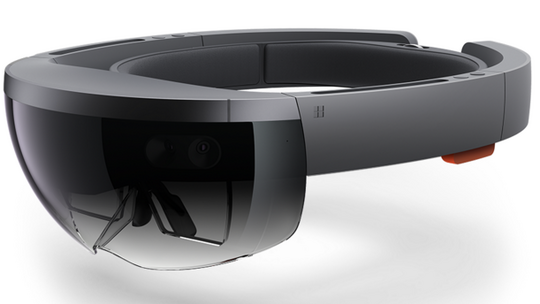

AR has the chance to actually replace that brick in your pocket.
According to a study from Consumer Business Review, augment reality - technology, like Google Glass, that overlays digital imaging to the real world - is estimated to generate $120 billion in revenue by 2020, compared with $3o billion from virtual reality. So, given the nearly $90 billion difference, why does VR get all the love?
"Virtual reality has already come around once," says Mark Ladd, CEO and Co-Founder with Lyteshot, a Chicago-based AR gaming platform. "There's a familiarity with it."
In 1995, Nintendo released the Virtual Boy, a table-top 3D video game console that was billed as one of the first consumer-facing VR devices. (It was a flop, discontinued less than a year after hitting the shelves). But VR has been in the pubic consciousness for over 20 years, with the technology remaining present in pop culture, even while actual headsets were struggling to gain market traction.
And with virtual reality, its vision and value-add are clear.
"Virtual reality is primarily used for gaming and entertainment and those categories tend to lead for mass consumer adoption," says Ladd. "AR is uncharted in terms of what the bigger opportunity is. Is it for gaming? Is it for communication? Is it for the enterprise?"
When Google Glass, AR's flagship product to date, came out in 2013, its enterprise value was clear, but the device didn't connect with the public. (In fact, the device inspired the rather damning descriptor, Glassholes, for people that wear the product). The Oculus Rift, arguably VR 2.0's flagship device, "is the complete opposite," says Ladd. It has connected with consumers even before it's available.
Another reason for VR's relative popularity is the prevalence of content that supports it. Though there's an arms race happening on the hardware side of AR - from the big guys like Epson, Micrsoft, and Magic Leap to the little guys like Laster, Atheer, and more - there's a lack of development happening in regards to applications and games.
With virtual reality, the New York times recently partnered with Google on a VR project, Apple Music just produced its first piece of VR content, and Star Wars released a trailer compatible with Google Cardboard.
"It's all about letting the content develop," says Ladd. "VR has a huge head start on this front. Content will make the case for these devices. Unless you can have an amazing experience with a headset, people are going to have a tough time buying in. And you need content for those amazing experiences. You don't have a ton of that with AR."
Fortunately, that should start to accelerate over the next couple of years, thanks to Microsoft's augment reality headset, the HoloLens, which is the "first holographic computer running Windows 10.” In October, Microsoft said that they'll be sending out developer kits in early 2016 and that it will use the Windows Holographic computing platform.
According to Business Insider, the HoloLens will use "Universal Windows Apps," allowing developers to build one app for every platform. This way, when the HoloLens launches, it will theoretically have access to a library of live apps, eliminating the content problem.
"Microsoft has done a great thing, giving AR a shot in the arm by tying the HoloLens into the rollout of Windows 10," says Ladd. "Traditionally, there's a sunk cost for developers when they have to pick a platform to build on; every developer is placing a bet on the right one to move forward with. Bringing AR to Windows 10 makes the development more universal and accessible, which will bring more people into this ecosystem."
However, Microsoft's all-in-strategy does reinforce another issue facing AR. Whereas virtual reality has a number of big-name companies, like Sony, Facebook, Google, Apple, and Samsung, entering the VR world on both the hardware and content sides, the AR industry is almost defined solely by its two biggest players, the HoloLens and Magic Leap. (Magic Leap is the "mysterious," buzzed-about AR project co-funded by Google).
"For a whole industry to come about, it can't just be about two companies," adds Ladd. "Yes, it's important for a company like Microsoft to be setting the bar, but consumers need to see an industry, not just one or two players."
So, given the obstacles facing AR, why is the industry still valued at nearly four times the amount of VR?
First, augment reality will extend beyond gaming and entertainment and into a variety of other industries, including the enterprise, industrial and medical arenas. For example, ambulance drivers currently use Google Glass to visually connect paramedics in the field, architects use AR to sell proposals and projects, and manufacturers leverage the tech to view machine data in real-time. (It's important to note that while there are certainly enterprise applications for VR, especially in training scenarios, AR casts a much wider B2B net).
Also, because most virtual reality headsets have front-facing cameras, they'll be able to "make that leap from VR to AR," says Ladd. But, most importantly, AR has the potential to replace more than just a consumer's gaming console. "AR can actually take the place of that brick in your pocket."
Because augmented reality provides a truly interactive experience, as opposed to an immersive one, AR has the ability to "become humans’ primary interface for interaction with the world." So, while VR offers next-gen gaming, AR is out to be next mobile.
Per an augmented reality white paper, "If the adoption curve of mobile phones is to repeat itself with glasses - within 10 years, over 1 billion humans will be wearing augment reality devices."
There's the love.
(Image via Wiki Commons)








